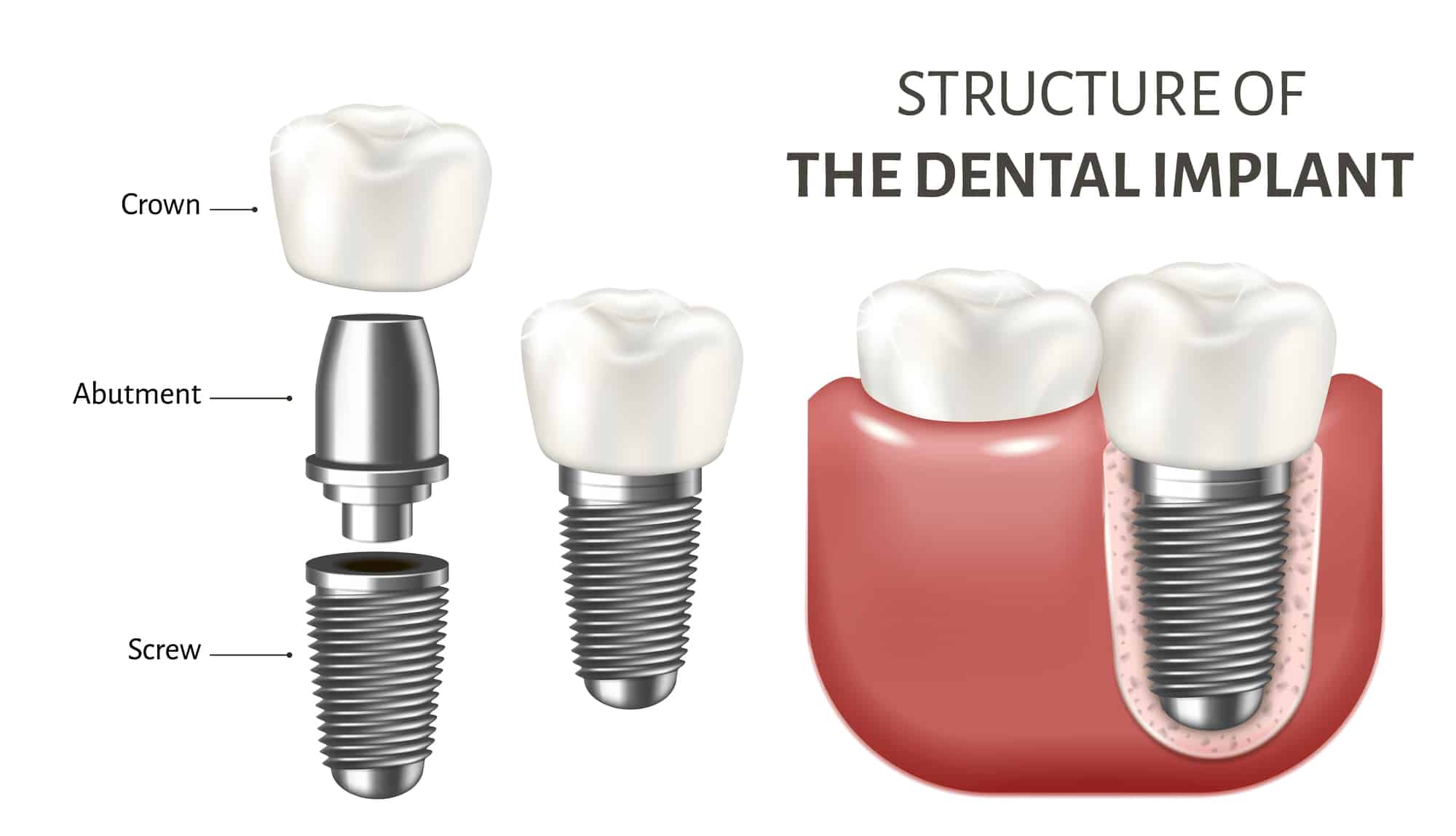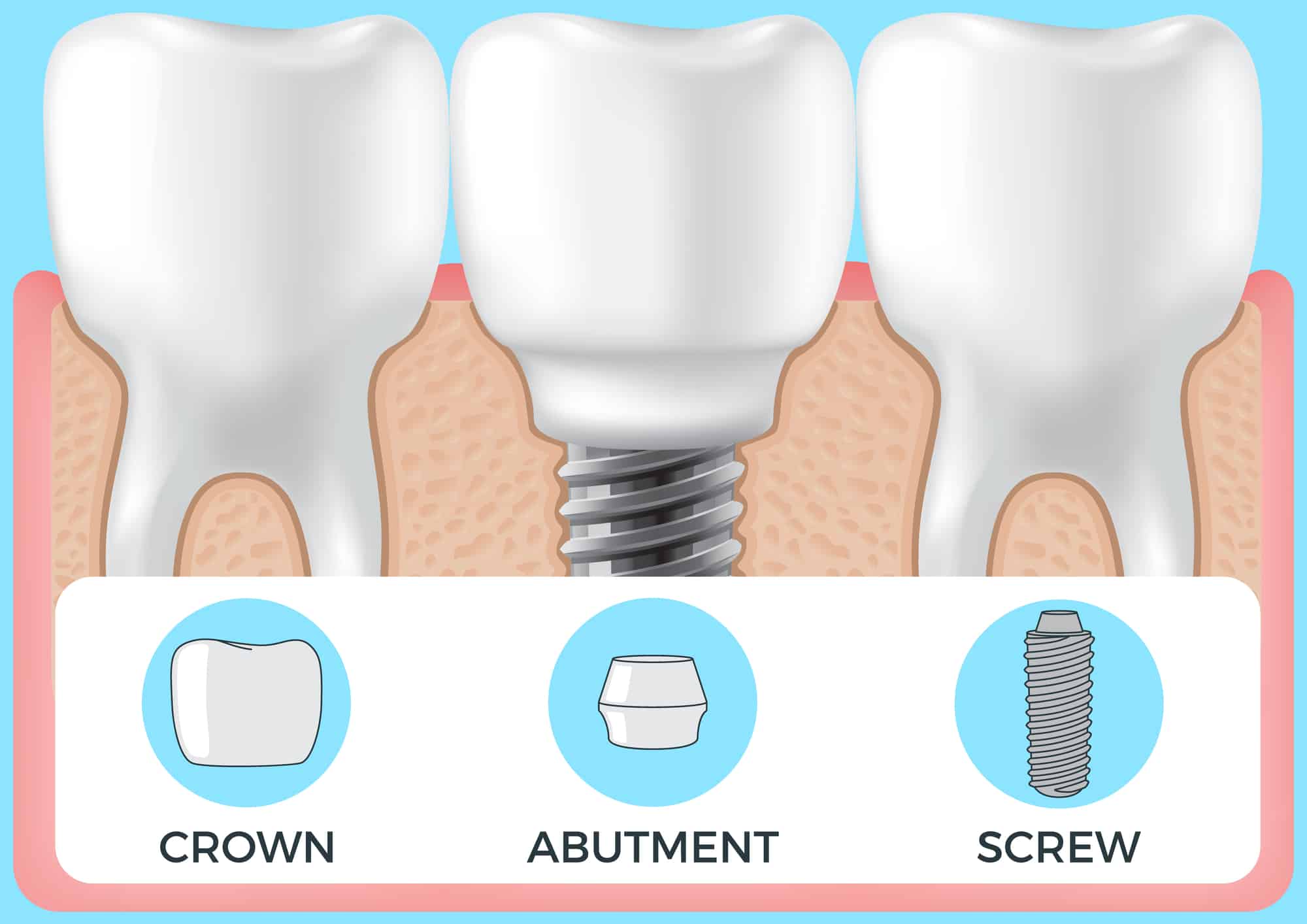When you think of an implant, possibly a false tooth that is placed to replace a missing piece comes to mind.
However, not everyone knows what the parts of a dental implant are.
Despite being one of the dental treatments with the highest success rate and demand, there is a certain lack of knowledge regarding the placement techniques and the different materials.
For this reason, in this article we would like to explain the parts of a dental implant and some essential aspects of this type of intervention.
What is a dental implant?
A dental implant is a fixed dental prosthesis, a small screw with a cylindrical shape whose purpose is to replace the root of a tooth that has been lost, for whatever reason.
In this way, it prevents bone loss caused by missing teeth and prevents adjacent teeth from moving, occupying the empty space that has been left.
In order to achieve full functionality of the bite and restore the aesthetics of the smile, a single or several dental crowns are placed on the implant.
The advantages of having an implant
When it comes to replacing a lost tooth, it is possible to opt for different prosthetic options – whether fixed or removable – although dental implants are undoubtedly the most durable restoration.
In addition to not affecting the adjacent teeth, as is the case with dental bridges, they act like a real tooth and provide the same naturalness.
Therefore, it allows eating and speaking with total normality, being suitable for any age.
Likewise, the psychological impact of having teeth that do not differ from real teeth, with respect to the feeling of using something more uncomfortable and less natural.
The parts of a dental implant
A dental implant is made up of three parts:
The body
This is the implant device itself, the screw that is inserted into the jawbone.
It acts as the root and anchors the rest of the prosthetic components.
The abutment
This is the part that connects the screw to the dental crown, so its function is to extend the body of the implant through the soft tissues (the gum).
The dental crown
It is a prosthesis that imitates the appearance of a natural tooth.
It is the visible part of the implant and therefore provides functionality and esthetics.
Although there are different types of dental crowns, the most commonly used in visible teeth are those made of zirconium.
You will be interested in ” How to place dental implants with little bone
Body, abutment and dental crown
Enlarge image
PARTS OF A DENTAL IMPLANT
Dental implant materials
In addition to the parts of a dental implant, we would like to explain the materials they are made of.
Generally, the dental implants most commonly used in dentistry are those made of titanium.
This is a biocompatible material that does not generate allergic reactions and has been used for many decades in the field of implantology.
Among its advantages, we highlight that it has a high resistance to corrosion and offers very reliable results over the years.
Even so, there are other types of materials with which implants have begun to be made, such as zirconium.
It is more difficult to find implants with this composite, as its use is not yet widespread.
Although it is also a biocompatible material and has similar characteristics to titanium, there are not many studies that support its long-term survival.
That is why at DrAW Dental Clinic we work with titanium implants.
Do not be left with any doubts
Knowing the parts of a dental implant does not seem too relevant, but the more information you have about a treatment, the more certain you will be.
What techniques are used to place a crown on implants?
There are two techniques for attaching the dental crown to the implant: the prosthesis can be screw-retained or cemented.
Both methods are frequently used in dental clinics, are effective and have both advantages and disadvantages.
The implantologist will determine which technique is the most appropriate in each case.
Screw-retained dental implant
It is easier to dismantle and remove if necessary, either due to problems related to the crown or due to the development of peri-implant diseases.
These conditions – mucositis and peri-implantitis – arise due to improper dental hygiene, so special attention should be paid to daily cleaning routines.
Techniques for dental implant placement
Enlarge image
SCREW-RETAINED IMPLANT
Cemented implant
The cemented prosthesis, on the other hand, favors better stability of the structure placed on the implant.
In addition, the procedure to place it is simpler, since the replacement of the crown on implants in the most unfavorable cases.
Implant placement times
During the surgical procedure the patient feels no pain, since it is performed under the effects of local anesthesia.
As for the time required, this varies considerably depending on the patient’s state of health and the technique used.
Thus, if it is necessary to proceed with the extraction of a natural tooth, it is important to bear in mind that the wound heals correctly.
Until this time has passed, which normally takes between 3 and 4 months, it is not possible to place the dental implant.
WE ARE EXPERTS IN IMPLANTOLOGY
Advanced techniques
On the other hand, the time it takes to place the implant and the crown can be shortened by using more modern and innovative methods, such as immediate loading.
Thanks to this technique, it is possible to place the implant together with the temporary dental crown at the same appointment with the implantologist.
However, it is necessary for the patient to meet a series of requirements for the operation to be carried out in this way:
Have a sufficient amount of bone.
Not to suffer from periodontal diseases.
Maintain an exhaustive hygiene after the operation.
Not be a bruxist or have malocclusions.
These people, if the specialist confirms it, can opt for computer-guided surgery.
This is a technique that allows the implantologist to know the exact point where the implant should be inserted, after planning through 3D technology.
This shortens the operation time and significantly improves the postoperative period.
Dental implant surgery
Enlarge image
GUIDED SURGERY
More traditional method
If the more traditional technique is followed, the implant will need to be osseointegrated and sufficiently stable to place the crown or another type of prosthesis on it.
In this case, the healing process will last between 6 and 8 weeks.
In 97.5% of cases, dental implants osseointegrate perfectly, which means a stable implant without mobility.
The importance of osseointegration
The osseointegration process is essential to ensure the success of the treatment.
It consists of the permanent union between the maxillary bone and the implant, achieving its complete stability and fixation.
When this healing does not occur, we say that there has been a rejection of the implant, so it is necessary to remove and replace it.
Although the chances of this happening are only 2.5%, so the intervention has a high success rate.
How do I know if I am a suitable person to have an implant?
As we announced at the beginning of this article, there are various options for replacing a lost tooth, either by means of a fixed or removable prosthesis.
The fact of choosing one or the other depends on several factors, including price, our requirements or oral health.
Before placing a dental implant it is essential that the mouth is healthy: free of tartar, caries, infectious foci and with periodontal diseases under control.
People who have little bone may not be the best candidates for a dental implant.
However, a previous bone graft or maxillary sinus elevation – depending on the case – can be performed to allow a better osseointegration of the implant.
Therefore, it is important to perform a thorough study of the mouth to allow the implantologist to determine the patient’s suitability for dental implants.
If you have more doubts about the parts of a dental implant, the techniques or its materials, do not ignore them and consult with our specialists at DrAW Dental Clinic.



